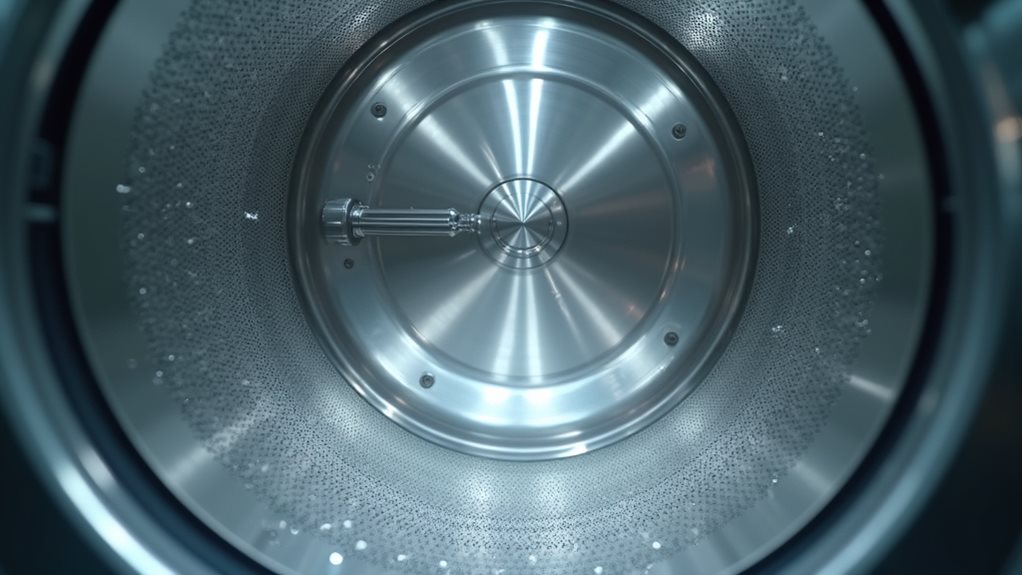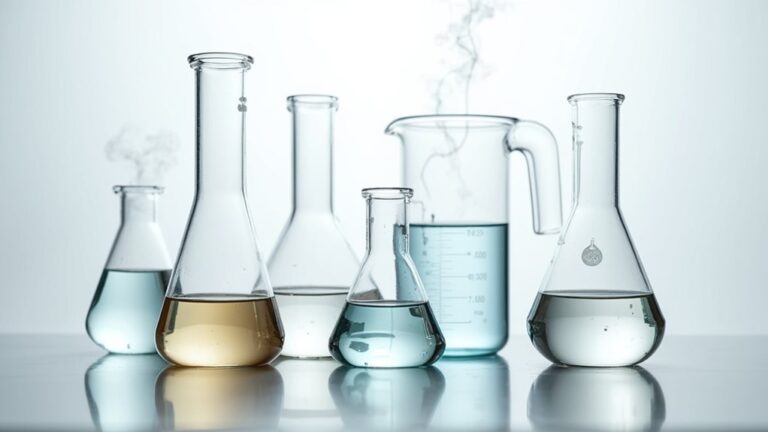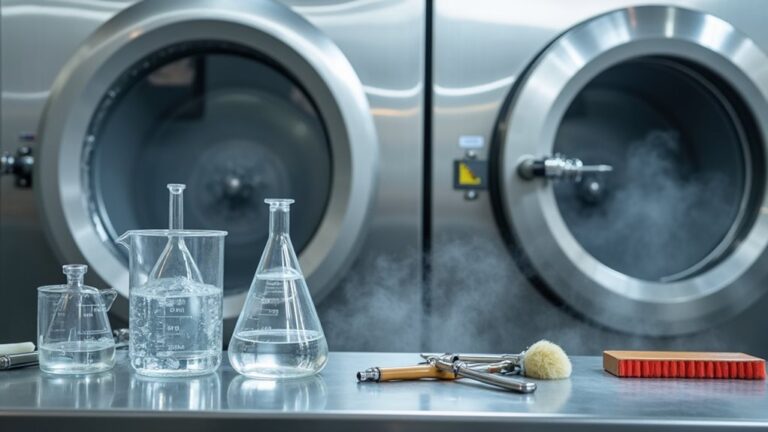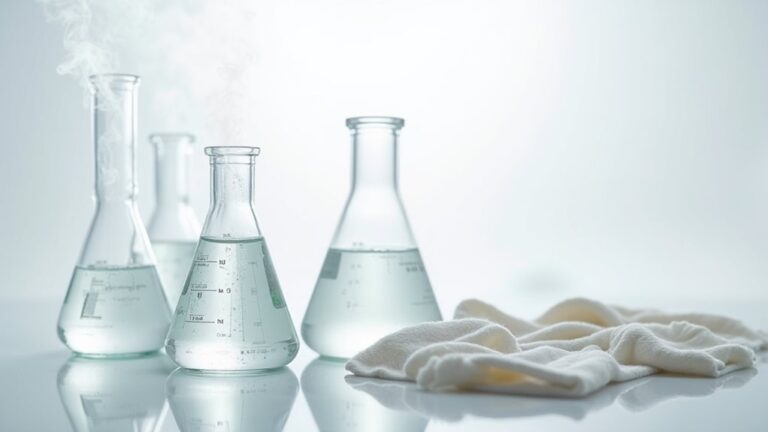Dry cleaning works by bathing your garments in chemical solvents like perchloroethylene instead of water, which protects delicate fabrics from shrinking while dissolving oils and stubborn stains that regular washing can’t touch. Professional cleaners first inspect and pre-treat problem areas, then run clothes through specialized machines at controlled temperatures, followed by post-cleaning inspection and careful pressing to restore that crisp, fresh appearance you love. There’s actually much more happening behind those swinging doors than you might expect.
What Is Dry Cleaning and How Does It Work
The mystery behind those “Dry Clean Only” labels unraveled for me during my first disastrous attempt at washing a wool blazer, which emerged from my washing machine looking like it belonged on a toddler rather than a working professional.
Here’s what I learned: the dry cleaning process uses chemical solvents instead of water, typically perchloroethylene, which brilliantly dissolves oils and grime without damaging delicate fabrics like silk or cashmere.
Chemical solvents like perchloroethylene work magic on delicate fabrics, dissolving stubborn oils and grime that water-based washing simply cannot handle.
Your garments get pre-treating stains attention first, then they’re gently agitated in cleaning solvents at controlled temperatures (not high temperatures like I mistakenly assumed).
Modern dry cleaning machines recover 99.99% of environmentally friendly solvents, making the process surprisingly eco-conscious.
It’s fundamentally a chemical bath that can remove stains water simply can’t touch! 😊
This method is particularly essential for structured garments like suits and formal wear, as it prevents shrinkage and color bleeding while maintaining the garment’s original shape and appearance.
The Step-by-Step Dry Cleaning Process
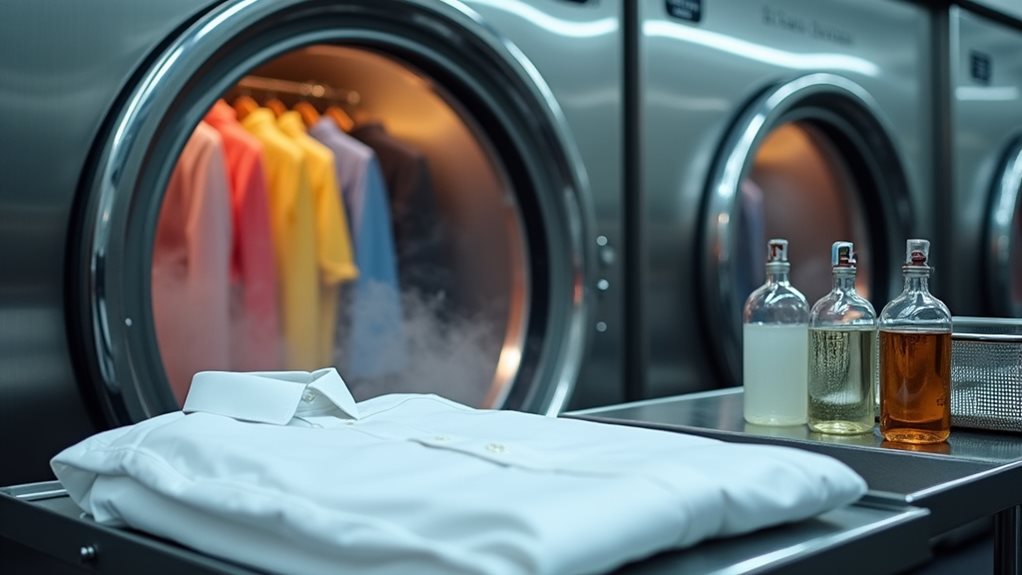
Five distinct stages transform your wrinkled, stained garments into pristine clothing, and I’ll walk you through each step after learning this process firsthand when I befriended my local dry cleaner during my frequent visits (thanks to my toddler’s artistic pasta sauce experiments on my work clothes).
First, your dry cleaning service inspects and tags each piece, checking pockets and identifying problem areas.
Next comes pre-spotting, where technicians apply targeted stain remover to stubborn marks.
Then, cleaning is a process involving specialized machines using non-water-based solvents at 30°C for 8-15 minutes—no water means delicate fabrics stay safe!
A post-spotting inspection catches any lingering stains, followed by finishing touches like steaming and pressing to make your garments look professionally perfect.
After cleaning, the solvent extraction phase removes the cleaning solution from garments while the chemical solvent is distilled and recycled for future use.
Solvents Used in Professional Dry Cleaning

When you’re curious about what actually cleans your clothes during the dry cleaning process, you’ll discover that professional cleaners rely on two main categories of solvents: traditional chemical options and newer eco-friendly alternatives.
The traditional route has long featured perchloroethylene (or “perc” as we call it in the business), which works like a charm for stubborn stains but comes with some serious health concerns that’ll make you think twice.
Today’s smarter cleaners are increasingly switching to safer alternatives like carbon dioxide systems and plant-based solvents, because honestly, who wants to worry about carcinogens when you’re just trying to keep your favorite blazer looking sharp? 😅
Another popular alternative gaining traction is hydrocarbon solvents, which offer a middle ground between safety and cleaning power, though they don’t quite match perc’s stain-fighting abilities.
Traditional Chemical Solvents
Four main chemical solvents have dominated the dry cleaning industry over the past century, and understanding them helps you make informed decisions about where to take your delicate garments.
Perchloroethylene, or “perc,” became the go-to dry cleaning solution in the 1930s because it’s incredibly effective at removing oil-based stains from your favorite silk blouse or wool suit. However, this powerhouse solvent comes with considerable health risks and environmental impact concerns that you should know about.
That’s why alternative solvents like liquid carbon dioxide and high-flash hydrocarbons have emerged as safer options. Modern machines excel at recycling solvent, capturing 99.99% for reuse, which honestly impressed me when I first learned about this efficiency.
Even trichloroethylene, once popular, has been largely phased out due to cancer concerns.
Environmentally conscious dry cleaners are increasingly adopting GreenEarth silicone-based solutions as a safer alternative to traditional chemical solvents.
Eco-Friendly Alternatives
The growing awareness of environmental and health concerns has sparked a revolution in dry cleaning technology, pushing the industry toward solvents that won’t make you worry about bringing your freshly cleaned clothes into your home.
These eco-friendly cleaning agents represent a notable shift from traditional toxic chemicals, offering sustainable solutions that protect both your family’s health and our planet’s future.
Modern eco-friendly alternatives include:
- Carbon dioxide cleaning – Uses pressurized CO2 as a completely non-toxic solvent
- High flashpoint hydrocarbons – Safer substitutes that dramatically reduce health risks
- Biodegradable silicone-based solvents – Chemical-free options that break down naturally
- Advanced solvent recovery systems – Technology that minimizes environmental impact through efficient recycling
These innovations prove you don’t have to sacrifice cleaning quality for environmental responsibility.
Unlike traditional water-based washing, these alternative solvents excel at dissolving oils and grease while remaining gentle on delicate fabrics that require specialized care.
Garment Inspection and Pre-Treatment Methods
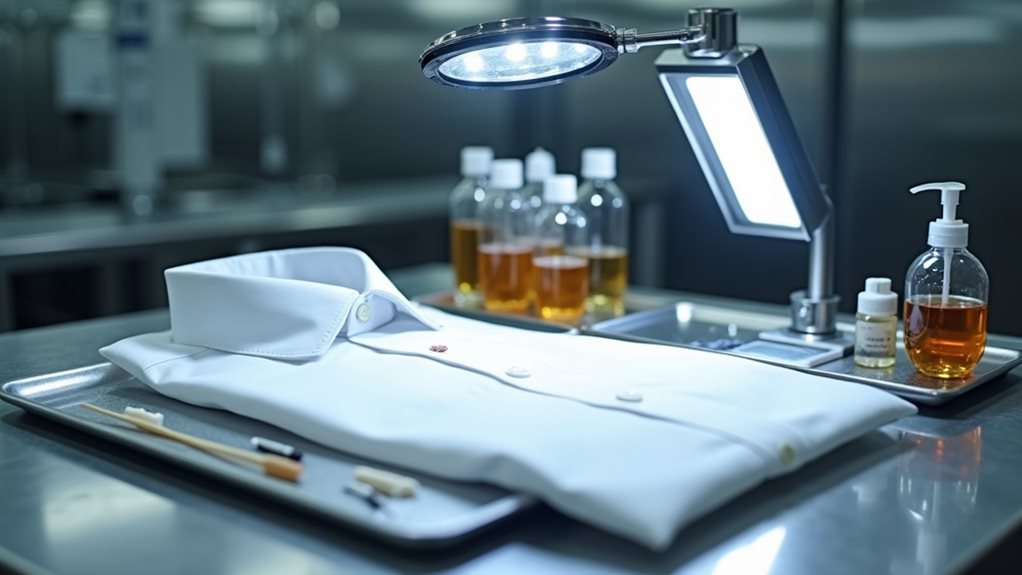
Before your favorite blazer even touches a drop of cleaning solvent, experienced dry cleaners become detectives, carefully examining every inch of fabric like they’re solving a mystery that could make or break your wardrobe.
This garment inspection involves a meticulous check for stains, damage, missing buttons, and forgotten treasures in your pockets (yes, they’ve found everything from gum to gold jewelry!).
Pre-treatment comes next, where professionals categorize stains by type—oil-based, water-based, or protein-based—then apply specific chemical solvents or heat directly to problem areas.
Using light boxes and magnifying glasses, they’ll spot stains you’d never notice, guaranteeing proper treatment before the actual cleaning process begins.
This careful preparation dramatically improves your chances of successful stain removal.
During this inspection phase, cleaners also check care labels to determine the most appropriate treatment method for each specific fabric type.
Machine Cleaning and Solvent Recovery
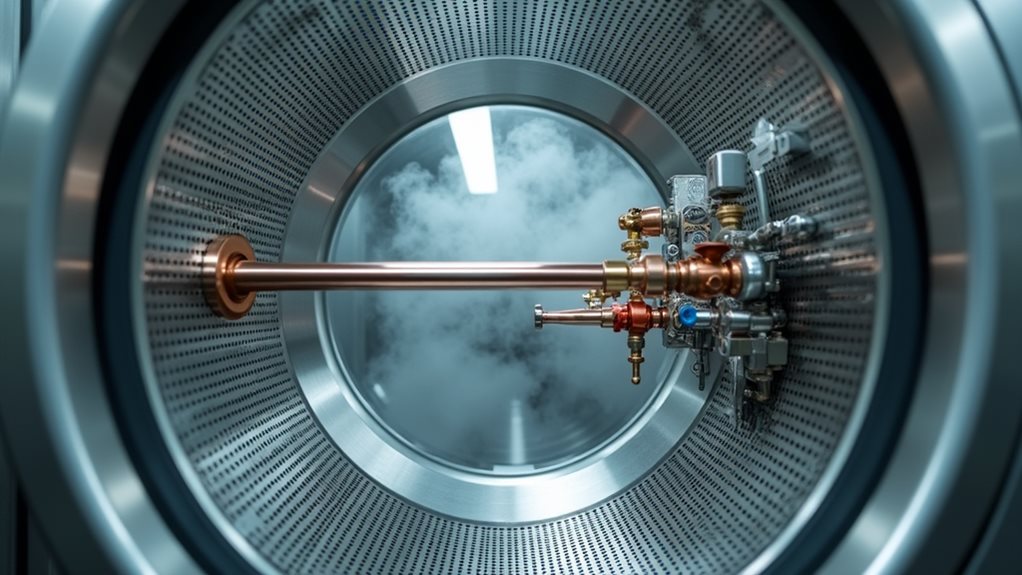
Once your garments have been carefully inspected and pre-treated, they’re loaded into sophisticated dry cleaning machines that work like gentle washing machines, except they use chemical solvents instead of water to lift away dirt, oils, and stubborn stains from delicate fabrics.
These remarkable machines operate at surprisingly cool temperatures—around 30°C—protecting your favorite silk blouse from heat damage while the non-water-based solvent works its magic through gentle agitation.
Here’s what happens during the cleaning process:
- Solvent circulation – Fresh distilled solvent rinses your garments thoroughly
- Recovery system – Machines reclaim 99.99% of solvent for reuse, making it environmentally friendly
- Drying cycle – Warm air (140-145°F) evaporates remaining solvent without damaging fabric
- Eco-friendly alternatives – Modern facilities increasingly use liquid carbon dioxide, dramatically reducing solvent waste
After the cleaning cycle completes, the machine’s distillation process purifies and recycles the used solvent, allowing dry cleaners to reuse the same cleaning solution multiple times while maintaining its effectiveness.
Post-Cleaning Inspection and Finishing Techniques
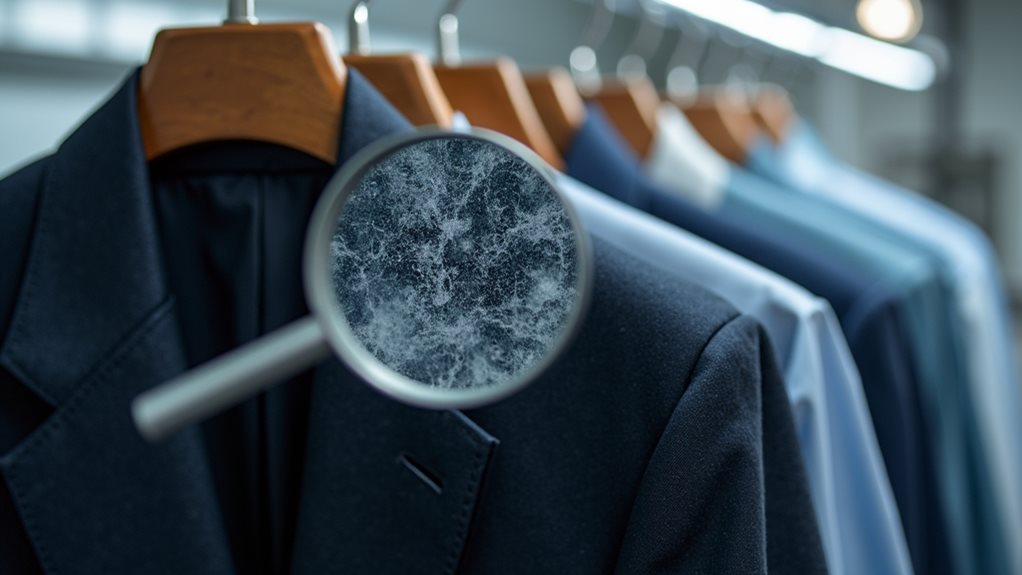
After your clothes emerge from their solvent bath looking refreshed, they’re not quite ready for your closet yet—think of this stage like getting a haircut where the real magic happens during the styling afterward.
During the post-cleaning inspection, experienced cleaners carefully examine every inch of your garment, hunting for any remaining stains that might’ve survived the cleaning process. If they spot trouble, they’ll apply specialized stain removal techniques until your clothes are spotless.
Next come the finishing techniques—steaming, pressing, and ironing—that transform wrinkled fabric into crisp perfection.
The final inspection guarantees buttons work, zippers glide effortlessly, and everything’s pristine before your garment gets tagged and organized, ready for delivery back to you. Throughout this entire post-cleaning phase, quality control checks ensure that every garment meets the dry cleaner’s standards before being packaged for customer pickup.
Environmental Impact and Green Alternatives

While your freshly cleaned clothes might look perfect hanging in your closet, there’s a hidden story behind that crisp appearance that’s been quietly unfolding in dry cleaning shops across the country—one that involves some pretty serious environmental and health concerns.
Traditional dry cleaning work relies heavily on perchloroethylene, a chemical that’s frankly scary when you dig into the research. Perchloroethylene and dry cleaning have been linked together for decades, but this solvent’s classified as a carcinogen, which honestly makes me think twice about that “fresh” smell.
Thankfully, the industry’s embracing eco-friendly alternatives that actually work:
- Liquid carbon dioxide cleaning uses pressurized CO₂ instead of toxic solvents
- High-flashpoint hydrocarbons offer safer petroleum-based options
- Wet cleaning techniques protect delicate fabrics without chemicals
- Regulatory frameworks now promote green alternatives over traditional methods
These environmental impacts matter, and you’ve got safer choices. To minimize exposure to any remaining chemical residues, always allow your dry cleaned items to air out completely before wearing them, especially garments that will be in close contact with your skin.
Getting the Best Results From Your Dry Cleaner
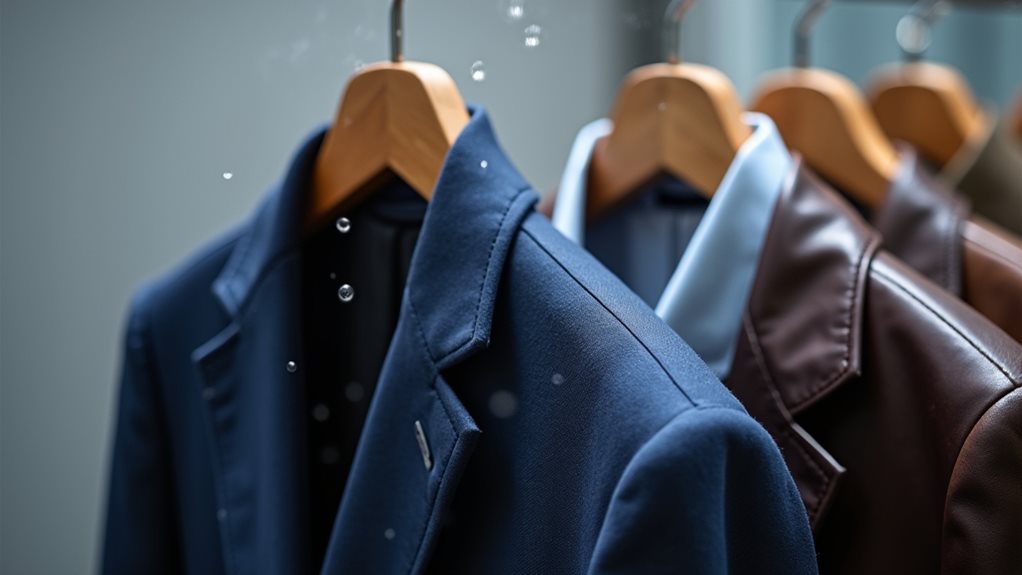
Since you’re already making the conscious choice to invest in professional dry cleaning, you might as well squeeze every bit of value from that relationship—and trust me, there’s a right way and a wrong way to work with your cleaner that can make the difference between clothes that look merely acceptable and garments that honestly make you feel like you stepped out of a magazine.
First things first: always check that care label before dropping anything off at your dry cleaners place, because modern dry cleaning works best when you understand what your delicate fabrics actually need.
Point out any oil-based stains or problem areas upfront, and don’t accept clothes back if they smell like cleaning solvent—that’s a red flag indicating poor technique that’ll leave you reconsidering home dry cleaning alternatives next time.
The professional pressing and finishing techniques used by quality dry cleaners are what create that crisp appearance that’s nearly impossible to replicate with home care methods.

